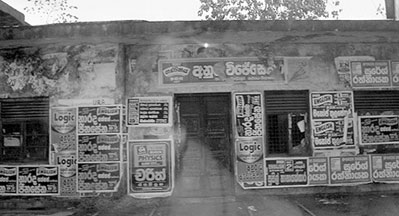The poster phenomenon
 There are many advertising media today, including electronic ones
which have attracted advertisers big and small. But even the powerful
electronic media have not been able to fully outdo the print media.
Print literally leaves a lasting impression on the viewer or reader as
the case may be. It is not for one fleeting moment (like electronic
media), but for a considerable period of time - even for all time. It is
physical, tangible, something we can reach out and touch. That is what
makes print unique. There are many advertising media today, including electronic ones
which have attracted advertisers big and small. But even the powerful
electronic media have not been able to fully outdo the print media.
Print literally leaves a lasting impression on the viewer or reader as
the case may be. It is not for one fleeting moment (like electronic
media), but for a considerable period of time - even for all time. It is
physical, tangible, something we can reach out and touch. That is what
makes print unique.
But not everyone has access to newspapers, the most preferred medium
for print advertising, due to economic or other reasons. This presents a
challenge for advertisers - how do you address the widest possible
audience via print without the target audience having to spend a cent ?
The answer - the humble poster.
Posters are everywhere in isle and one can hardly find a wall that
has not been 'adorned' by these gems. From tuition masters advertising
their classes to film directors praising their own creations, posters
have invaded practically every nook and corner of the land. Now that an
election is at hand, one cannot forget the politicians who simile at us
from every wall big and small.
The poster has become an essential marketing tool for almost
everything one can imagine. It may cost millions of rupees to produce
and paste a full-colour poster, but most advertisers seem to think that
the 'return' from the wide exposure is substantial. It is no secret that
in provincial and general elections, candidates who have a 'street
presence' by way of posters invariably get a higher percentage of votes.
Similarly, there seems to be more pupils in the tuition classes of
teachers who advertise their credentials all over the island. This
reinforces the concept that saturation poster coverage works
effectively.
 A well designed poster works. It stops people in their tracks, makes
them look at it twice and leads to the formation of an opinion of the
product/person advertised in the mind of the viewer. It is rare to find
a solitary poster - we often find dozens of copies of the same poster on
one wall to attract the eyes of passersby. A well designed poster works. It stops people in their tracks, makes
them look at it twice and leads to the formation of an opinion of the
product/person advertised in the mind of the viewer. It is rare to find
a solitary poster - we often find dozens of copies of the same poster on
one wall to attract the eyes of passersby.
One cannot discern the logic behind this practice, but the idea seems
to be that one is not likely to miss a lot of posters, although it would
be easy to miss just one, however colourful and informative it may be.
But this very practice has led to posters becoming known as a menace.
City walls have become an eyesore thanks to the large number of posters
on every subject under the sun. Not even school and private residences'
walls have been spared despite the appeal 'stick no bills' or Denveem
alaveema thahanam in Sinhala. Walls are not the only target either -
lamp posts, shop shutters, broken down vehicles are all fair game. No
room is literally left alone in the poster war.
Apart from the 'eyesore' factor, the environment factor should also
be considered. The massive of amount of paper required for a poster run
is in itself a serious dent on the environment. Posters take quite some
time to decay, adding to the environment's woes. When posters are taken
off by the local bodies, they have to be taken to landfills, thus
aggravating the garbage disposal problem. The very act of removing
posters can cause environmental damage in other ways as well. Besides,
it is an expensive, labour-intensive, time consuming operation that
costs the taxpayer dearly. Clearly, the negatives of the poster
phenomenon far outweigh the positives. All things considered, it is not
as cost effective as one thinks it is.
But is there an alternative ? This is a very challenging question.
Freedom of expression is enshrined in our Constitution and banning
posters is simply out of the question. Posters are not going to go away
- that is a fact of life. As stated earlier, one cannot deny they get
the message across, regardless of the damage to the environment - and
our collective conscience.
One solution, which has already been tried on a limited scale, is the
erection of blank hoardings/billboards solely for the purpose of pasting
posters. More of these should be erected and should be positioned
prominently at key places accessed by the public. Advertisers must be
encouraged to 'stick' to these hoardings instead of using walls.
The authorities could even provide monetary incentives to local
bodies that wish to erect such billboards. Electronic advertising
devices have also come up in various parts of the City and the
authorities should make them more accessible and affordable to average
advertisers.
 We do not know whether there is a legal deterrent mechanism to
prevent the pasting of posters on designated walls and in specified
areas. In that case, such laws must be stringently enforced. If there
are no such laws, they can be introduced. The authorities could also
explore the possibility of defining particular types of
environment-friendly paper for printing posters. Other relevant
parameters could also be defined. We do not know whether there is a legal deterrent mechanism to
prevent the pasting of posters on designated walls and in specified
areas. In that case, such laws must be stringently enforced. If there
are no such laws, they can be introduced. The authorities could also
explore the possibility of defining particular types of
environment-friendly paper for printing posters. Other relevant
parameters could also be defined.
As for election propaganda, more free and paid-for airtime must be
granted on electronic media for candidates to air their views and
solicit votes. That is one solution to veer them away from posters. Of
course, one should also take into consideration the very nature of the
proportional representation system whereby candidates have to engage in
propaganda activities throughout an entire district. Reverting to the
old system or a mixture of old and new system could automatically cure
the poster disease to a great extent.
The challenge is to balance the needs of the advertisers and the
concerns regarding the environment and the economy. This will not be an
easy task given that the 'poster culture' is ingrained in society. We
take them for granted and believe that we are powerless to do anything
about it. Yet, we should take a leaf from developed countries where
posters are rarely seen except in designated places.
That is the ideal scenario that we should strive to achieve. |

